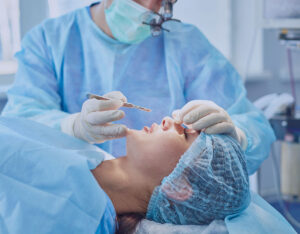| Table of Contents |
TO THE EDITOR
 Patients undergoing cosmetic surgery are predominantly healthy, working-age patients hoping to enhance and rejuvenate their appearance and improve their self-esteem. Worldwide, there is growing interest in and increased volume of office-based and ambulatory cosmetic surgical procedures. According to the International Society of Aesthetic Plastic Surgery, Colombia has emerged as a top destination for cosmetic surgery, ranking second in South America after Brazil and fourth in the continent after the U.S. and Mexico in number of annual cosmetic procedures.1,2 In 2022 alone, 470,000 cosmetic surgical procedures were performed in Colombia.1 Common surgical procedures include blepharoplasty, facelift, rhinoplasty, breast augmentation and reduction, abdominoplasty, liposuction, and nonsurgical procedures such as injectables, facial rejuvenation, and hair removal.1
Patients undergoing cosmetic surgery are predominantly healthy, working-age patients hoping to enhance and rejuvenate their appearance and improve their self-esteem. Worldwide, there is growing interest in and increased volume of office-based and ambulatory cosmetic surgical procedures. According to the International Society of Aesthetic Plastic Surgery, Colombia has emerged as a top destination for cosmetic surgery, ranking second in South America after Brazil and fourth in the continent after the U.S. and Mexico in number of annual cosmetic procedures.1,2 In 2022 alone, 470,000 cosmetic surgical procedures were performed in Colombia.1 Common surgical procedures include blepharoplasty, facelift, rhinoplasty, breast augmentation and reduction, abdominoplasty, liposuction, and nonsurgical procedures such as injectables, facial rejuvenation, and hair removal.1
Unfortunately, cosmetic surgery is not without risk. In Columbia, cosmetic surgery is mainly a private-sector endeavor that frequently eludes regulatory frameworks.3 While many patients receive adequate care, substandard medical and surgical practices, poor infection control, and outdated medical equipment can increase risks.4 The increased demand for cosmetic procedures, driven by beauty ideals and economic factors, can lead to inappropriate practices and inadequate patient selection, increasing the risk of potential complications.5 There are many anecdotal reports of severe adverse events, including perioperative mortality related to cosmetic procedures, that mainly appear in the lay press and less in the medical literature.6,7 Worldwide, mortality associated with anesthesia is between 1 in 100,000 to 200,000 patients.2,8-10 In Colombia, although no official government data exist, retrospective data show the mortality rate of cosmetic procedures could be up to ten times higher than the global numbers, and could be up to 1 in 20,000 patients.11
Further scrutiny and a forceful response to this patient safety concern are warranted. Reducing the complication rate and perioperative mortality in cosmetic procedures worldwide should be a goal that requires the collective commitment of anesthesia professionals, cosmetic surgeons, and their respective medical associations.12
We seek guidance from the Anesthesia Patient Safety Foundation (APSF) to improve our current practices regarding cosmetic surgery and anesthesia in Colombia.
By providing us with resources, information, insights, and guidance, the APSF can play a pivotal role in enhancing the current practice standards, safety, quality, and patient satisfaction for this patient population.
Luis Fernando Álvarez is a Patient Safety Committee Coordinator at the Sociedad Colombiana de Anestesia y Reanimacion (S.C.A.R.E), Bogota, Colombia, South America
Felipe Urdaneta, MD, FASA is a Clinical Professor Anesthesiology at the University of Florida, Gainesville, Florida, USA
Felipe Urdaneta is a consultant for Medtronic.
Luis Fernando Álvarez does not have any conflicts of interest.
REFERENCES
- International Society of Aesthetic Plastic Surgery. ISAPS 2022 Global Survey Results on Aesthetic/Cosmetic Procedures. September 2023. Available at: https://www.isaps.org/articles/isaps-blog/2023/isaps-2022-global-survey-results/.
- Bastidas-Goyes LG, Mendez-Castillo E, Bonilla-Estévez CM. Ethical and legal analysis of medical tourism in Colombia. Risks in communicative instrumentalization. 2021. Revista de Bioetica y Derecho. 2021;52:121-138.
- Pereira RT, Malone CM, Flaherty GT. Aesthetic journeys: a review of cosmetic surgery tourism. J Travel Med. 2018; 25(1).
- Ownby J. Six phony plastic surgeons convicted of using fake degrees in Colombia. El Pais. 2023. Available at https://english.elpais.com/international/2023-10-05/six-phony-plastic-surgeons-convicted-of-using-fake-degrees-in-colombia.html.
- Raggio BS, Brody-Camp SA, Jawad BA, et al. Complications Associated with Medical Tourism for Facial Rejuvenation: A Systematic Review. Aesthetic Plast Surg. 2020;44(3):1058-1065.
- Beltran L. Deadly Cosmetic surgeries in Latin America: A problem of self-esteem. El Pais. 2023. Available at https://english.elpais.com/international/women-leaders-of-latin-america/2023-10-25/deadly-cosmetic-surgeries-in-latin-america-a-problem-of-self-esteem.html.
- Ramirez CB. Los Riesgos en los “combos”de cirugías estéticas de más de 5 horas. El Tiempo. 2019. Available at https://www.eltiempo.com/colombia/cali/riesgos-por-combos-de-cirugias-esteticas-403914.
- Aitkenhead AR, Irwin MG. Deaths associated with anaesthesia – 65 years on. Anaesthesia. 2021;76(2): 277-280.
- Mantilla Correa AM, Zapata Potina AM, Rendon Bello FA. Caracterización de la mortalidad en los pacientes que se sometieron a procedimientos estéticos en Santiago de Cali – Valle del Cauca, en el periodo 2016-2020. Rev Mex Med Forense. 2023;8(1):75-92.
- Li G, Warner M, Lang BH et al. Epidemiology of anesthesia-related mortality in the United States, 1999-2005. Anesthesiology. 2009;110(4):759-65.
- Medellin S, Sessler DI. Preventable anesthetic deaths are not the major perioperative problem. Lancet Reg Health West Pac. 2023;37:100821.
- Ramirez Sierra YA. Challenges of medical and health tourism: a literature review from 2009 to 2020. 2021. Available at https://rcientificas.uninorte.edu.co/index.php/economia/article/view/13928.
REPLY
Office-based Aesthetic Procedures: How Can We Make It Safer?
We read with interest the letter from Alvarez and Urdaneta regarding improving safety for office-based cosmetic procedures in Colombia.
Over the last decades, the number of outpatient procedures has increased exponentially, with office-based procedures comprising a significant proportion due to ever-increasing demand for cosmetic procedures.1-3 As the authors have alluded to in their letter, there are safety concerns related to the location of procedure, patient selection, surgeon or proceduralist qualifications, and credentialing.
Facilities that provide office-based aesthetic procedures should not only have adequate resources in terms of equipment, personnel, space, but also access to critical medications to manage emergencies, such as anaphylaxis, local anesthetic toxicity, difficult airway, etc.4 Regulations for quality standards and accreditation of such centers might vary by state or country and play an important role in maintaining safety.4
Professional society guidelines, such as the American Society of Anesthesiologists Guidelines for Office-Based Anesthesia, address patient selection, monitoring, facility management, as well the qualification, training, and credentialing of anesthesia providers.5,6
Equally important is the training, qualification, and credentialing of the surgeons or proceduralists performing the procedures. For example, the American Board of Cosmetic Surgery (ABCS) certifies physicians including internists and dermatologists who may market themselves as board-certified cosmetic surgeons and might perform complex procedures outside of the scope of their certification.7
The APSF recently published a consensus statement for the safe conduct of nonoperating room anesthesia in a report from the 2022 Stoelting Conference, outlining provision of safe anesthesia and addressing the important considerations such as facilities set up and management, equipment, medication and supplies, staffing, perioperative care and quality assurance. This document, along with other existing office-based practice guidelines could serve as a blueprint for setting up and operating cosmetic procedures centers.8
We hope this letter helps outline a general roadmap for increasing and maintaining safety of aesthetic procedures. The implementation of guidelines and protocols requires constant awareness and commitment, from both clinicians and facilities.
Diana Anca, MD is associate professor of clinical anesthesiology at Weill Cornell School of Medicine.
Richard D. Urman, MD is the Jay J. Jacoby Professor & Chair of the Department of Anesthesiology at The Ohio State University.
Diana Anca does not have any conflicts of interest.
Richard D. Urman is the co-founder of the Institute for Safety in Office-Based Surgery and secretary of the Society for Ambulatory Anesthesia.
REFERENCES
- Osman BM, Shapiro FE. Office-based Anesthesia: A Comprehensive Review and 2019 Update. Anesthesiol Clin. 2019;37(2);317.
- Shapiro FE, Urman RD. The paradigm of 6 P’s: Defining the essence of a safe clinical office-based practice. J Clin Anesth. 2023; 90: 111239.
- Cosmetic Surgery National Data Bank Statistics. Aesthet Surg J. 2016;36 Suppl 1:1-29.
- De Lima A, Osman BM, Shapiro FE. Safety in office-based anesthesia: an updated review of the literature from 2016-2019. Curr Opin Anaesthesiol.2019;32(6):749-755.
- American Society of Anesthesiologists Committee on Ambulatory Surgical Care. Statement on Office Based Anesthesia. Oct 2019. Accessed at Statement on Office Based Anesthesia (asahq.org)
- American Society of Anesthesiologists Committee on Ambulatory Surgical Care. Statement on Qualification of Anesthesia Providers in the Office-Based Setting. Oct.2019 Accessed at Statement on Qualifications of Anesthesia Providers in the Office-Based Setting (asahq.org)
- Long EA, Gabrik K, Janis JE, et al. Board Certification in Cosmetic Surgery: An Evaluation of Training Backgrounds and Scope of Practice. Plast Reconstr Surg. 2020;146(5):1017-1023.
- Beard J, Methangkool E, Angus S, et al. Consensus Recommendations for the Safe Conduct of Nonoperating Room Anesthesia: A Meeting Report from the 2022 Stoelting Conference of the Anesthesia Patient Safety Foundation; Anesth Analg.2023;137(2): e8-e11.

 Articles
Articles